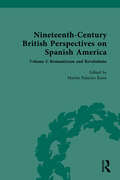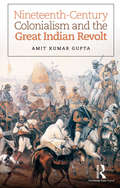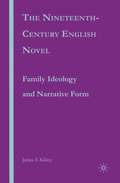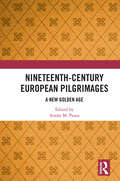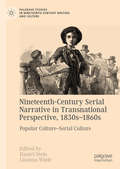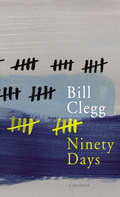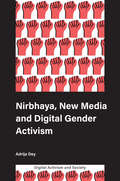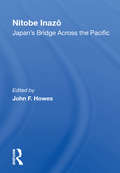- Table View
- List View
Nineteenth-Century British Perspectives on Spanish America: Volume I: Romanticism and Revolutions
The sources in this volume focus on Great Britain’s moral, financial, and diplomatic interventions and ambitions in Latin America. It begins during the wars of independence spanning 1810-1825, when Foreign Secretary George Canning prematurely declared, "Spanish America is free; and if we do not mismanage our affairs sadly, she is English." The independence movements of the former Spanish and Portuguese colonies, as well as their ancient past, inspired Romantic writers such as Anna Letitia Barbauld and spurred British military support and political debate, as attested by mercenary Richard Vowell’s Campaigns and Cruises in Venezuela and James Mill's "Emancipation of Spanish America."
Nineteenth-Century British Secularism: Science, Religion and Literature (Histories of the Sacred and Secular, 1700-2000)
by Michael RectenwaldNineteenth-Century British Secularism offers a new paradigm for understanding secularization in the nineteenth century. It addresses the crisis in the secularization thesis by foregrounding a nineteenth-century development called 'Secularism' – the particular movement and creed founded by George Jacob Holyoake from 1851 to 1852. Nineteenth-Century British Secularism rethinks and reevaluates the significance of Holyoake's Secularism, regarding it as a historic moment of modernity and granting it centrality as both a herald and exemplar for a new understanding of modern secularity. In addition to Secularism proper, the book treats several other moments of secular emergence in the nineteenth century, including Thomas Carlyle's 'natural supernaturalism', Richard Carlile's anti-theist science advocacy, Charles Lyell's uniformity principle in geology, Francis Newman's naturalized religion or 'primitive Christianity', and George Eliot's secularism and post-secularism.
Nineteenth-Century China: Five Imperialist Perspectives (Michigan Monographs In Chinese Studies #13)
by Dilip BasuMaterials from the past that wrongly anticipate the future, or present information or judgments that are later proved misleading or erroneous, are sometimes overlooked in reconstructing the past. Yet such documents are as legimiate, and perhaps as important, as those that are vindicated by events or continue to share perspectives with later generations. The five documents reproduced in Nineteenth-Century China are typical of the periods from which they come, but each was overtaken or contradicted by events. Collected with a belief in the legitimacy of attempting to see every period as much as possible in its own terms, these texts offer a glimpse of what China looked like and suggested to Englishmen on the spot in Canton and Hong Kong in the first half of the nineteenth century, and how they viewed their own country and its role vis-à-vis the China they observed. The first two texts in Nineteenth-Century China exemplify the imperialist mind’s eagerness to explore the world, to get a picture of all of its parts, and as rapidly as possible to “open” all areas to the benificent influence of the West, notably through an expanded commerce that would enrich its Western masters. Samuel Ball’s “Observations” (1817) show how much detailed information was available to Westerners and what the mercantile British were after, and an anonymous dissertation (1838) provides an example of the dream of the China as El Dorado: an immense population of eager traders, hard workers, and willing buyers. The third text (1845) is an early foreshadowing by a colonial official, R. M. Martin, of Western imperial arguments, rationalizations, and attitudes that would become common fifty years later. The fourth selection consists of an exchange of correspondence in 1847 about British access to and use of land in the vicinity of Canton. A short statement of purpose (1848) from the Morrison Education Society, demonstrating a missionary enterprise combining Christian evangelism and English education, concludes the book.
Nineteenth-Century Colonialism and the Great Indian Revolt
by Amit Kumar GuptaThis book examines the ruptured characteristics of colonialism in nineteenth-century India. It connects the British East India Company’s efforts at the bourgeoisation of India with the Revolt of 1857. The volume shows how the mutiny of Indian sepoys in the British Indian army became a popular uprising of peasants, artisans and discontented aristocrats against the British. Tracing the rationale and consequences of this conflict, the monograph highlights how newly introduced political, economic and agrarian policies as part of industrial Britain’s colonial policy wreaked havoc, resulting in high land revenue assessment and its harsh mode of collection, rural indebtedness, steady immiseration of peasants, widespread land alienation, destitution and suicide. Using rare archival sources, this book will be an important intervention in the study of nineteenth-century India, and will deeply interest scholars and researchers of modern Indian history and politics.
Nineteenth-Century Colonialism and the Great Indian Revolt
by Amit Kumar GuptaThis book examines the ruptured characteristics of colonialism in nineteenth-century India. It connects the British East India Company’s efforts at the bourgeoisation of India with the Revolt of 1857. The volume shows how the mutiny of Indian sepoys in the British Indian army became a popular uprising of peasants, artisans and discontented aristocrats against the British. Tracing the rationale and consequences of this conflict, the monograph highlights how newly introduced political, economic and agrarian policies as part of industrial Britain’s colonial policy wreaked havoc, resulting in high land revenue assessment and its harsh mode of collection, rural indebtedness, steady immiseration of peasants, widespread land alienation, destitution and suicide. Using rare archival sources, this book will be an important intervention in the study of nineteenth-century India, and will deeply interest scholars and researchers of modern Indian history and politics.
The Nineteenth-Century English Novel: Family Ideology and Narrative Form
by J. KilroyThrough analysis of eight English novels of the Nineteenth century, this work explores the ways in which the novel contributes to the formation of ideology regarding the family, and, conversely, the ways in which changing attitudes toward the family shape and reshape the novel.
Nineteenth-Century European Pilgrimages: A New Golden Age
by Antón M. PazosDuring the Nineteenth-Century a major revival in religious pilgrimage took place across Europe. This phenomenon was largely started by the rediscovery of several holy burial places such as Assisi, Milano, Venice, Rome and Santiago de Compostela, and subsequently developed into the formation of new holy sites that could be visited and interacted with in a wholly Modern way. This uniquely wide-ranging collection sets out the historic context of the formation of contemporary European pilgrimage in order to better understand its role in religious expression today. Looking at both Western Catholic and Eastern Orthodox Europe, an international panel of contributors analyse the revival of some major Christian shrines, cults and pilgrimages that happened after the rediscovery of ancient holy burial sites or the constitution of new shrines in locations claiming apparitions of the Virgin Mary. They also shed new light on the origin and development of new sanctuaries and pilgrimages in France and the Holy Land during the Nineteenth Century, which led to fresh ways of understanding the pilgrimage experience and had a profound effect on religion across Europe. This collection offers a renewed overview of the development of Modern European pilgrimage that used intensively the new techniques of organisation and travel implemented in the Nineteenth-Century. As such, it will appeal to scholars of Religious Studies, Pilgrimage and Religious History as well as Anthropology, Art, Cultural Studies, and Sociology.
Nineteenth-Century European Pilgrimages: A New Golden Age
by Antón M. PazosDuring the Nineteenth-Century a major revival in religious pilgrimage took place across Europe. This phenomenon was largely started by the rediscovery of several holy burial places such as Assisi, Milano, Venice, Rome and Santiago de Compostela, and subsequently developed into the formation of new holy sites that could be visited and interacted with in a wholly Modern way. This uniquely wide-ranging collection sets out the historic context of the formation of contemporary European pilgrimage in order to better understand its role in religious expression today. Looking at both Western Catholic and Eastern Orthodox Europe, an international panel of contributors analyse the revival of some major Christian shrines, cults and pilgrimages that happened after the rediscovery of ancient holy burial sites or the constitution of new shrines in locations claiming apparitions of the Virgin Mary. They also shed new light on the origin and development of new sanctuaries and pilgrimages in France and the Holy Land during the Nineteenth Century, which led to fresh ways of understanding the pilgrimage experience and had a profound effect on religion across Europe. This collection offers a renewed overview of the development of Modern European pilgrimage that used intensively the new techniques of organisation and travel implemented in the Nineteenth-Century. As such, it will appeal to scholars of Religious Studies, Pilgrimage and Religious History as well as Anthropology, Art, Cultural Studies, and Sociology.
Nineteenth-Century Female Poisoners: Three English Women Who Used Arsenic to Kill
by V. NagyNineteenth-Century Female Poisoners investigates the Essex poisoning trials of 1846 to 1851 where three women were charged with using arsenic to kill children, their husbands and brothers. Using newspapers, archival sources (including petitions and witness depositions), and records from parliamentary debates, the focus is not on whether the women were guilty or innocent, but rather on what English society during this period made of their trials and what stereotypes and stock-stories were used to describe women who used arsenic to kill. All three women were initially presented as 'bad' women but as the book illustrates there was no clear consensus on what exactly constituted bad womanhood.
Nineteenth-Century Fiction and the Production of Bloomsbury: Novel Grounds (Palgrave Studies in Nineteenth-Century Writing and Culture)
by Matthew InglebyThis study explores the role of fiction in the social production of the West Central district of London in the nineteenth century. It tells a new history of the novel from a local geographical perspective, tracing developments in the form as it engaged with Bloomsbury in the period it emerged as the city’s dominant literary zone. A neighbourhood that was subject simultaneously to socio-economic decline and cultural ascent, fiction set in Bloomsbury is shown to have reconceived the area’s marginality as potential autonomy. Drawing on sociological theory, this book critically historicizes Bloomsbury’s trajectory to show that its association with the intellectual “fraction” known as the ‘Bloomsbury Group’ at the beginning of the twentieth century was symptomatic rather than exceptional. From the 1820s onwards, writers positioned themselves socially within the metropolitan geography they projected through their fiction. As Bloomsbury became increasingly identified with the cultural capital of writers rather than the economic capital of established wealth, writers subtly affiliated themselves with the area, and the figure of the writer and Bloomsbury became symbolically conflated.
The Nineteenth-Century Press in the Digital Age (Palgrave Studies in the History of the Media)
by J. MussellJames Mussell provides an accessible account of the digitization of nineteenth-century newspapers and periodicals. As studying this material is essential to understand the period, he argues that we have no choice but to engage with the new digital resources that have transformed how we access the print archive.
Nineteenth-Century Serial Narrative in Transnational Perspective, 1830s−1860s: Popular Culture—Serial Culture (Palgrave Studies in Nineteenth-Century Writing and Culture)
by Daniel Stein Lisanna WieleThis volume examines the emergence of modern popular culture between the 1830s and the 1860s, when popular storytelling meant serial storytelling and when new printing techniques and an expanding infrastructure brought serial entertainment to the masses. Analyzing fiction and non-fiction narratives from the United States, France, Great Britain, Germany, Austria, Turkey, and Brazil, Popular Culture—Serial Culture offers a transnational perspective on border-crossing serial genres from the roman feuilleton and the city mystery novel to abolitionist gift books and world’s fairs.
The Nineties: When Surface Was Depth
by Michael Bracewellthe first clear anatomy of a confused decade, the 1990s – ‘Bracewell, with great verve and style, animates the cultural conversation’, Greil Marcus
Ninety Days: A Memoir Of Recovery
by Bill CleggThe goal is ninety: just ninety clean and sober days to loosen the hold of the addiction that caused Bill Clegg to lose everything. With seventy-three days in rehab behind him he returns to New York and attends two or three meetings each day. It is in these refuges that he befriends essential allies including the seemingly unshakably sober Asa, and Polly, who struggles daily with her own cycle of recovery and relapse. At first, the support is not enough: Clegg relapses for the first time with only three days left, turning his calendar back to day one. Written with uncompromised immediacy, Ninety Days begins where Portrait of an Addict as a Young Man ends - and tells the wrenching story of Bill Clegg's battle to reclaim his life. As any recovering addict knows, hitting rock bottom is just the beginning.
Ninigret, Sachem of the Niantics and Narragansetts: Diplomacy, War, and the Balance of Power in Seventeenth-Century New England and Indian Country
by Julie A. Fisher David J. SilvermanNinigret (c. 1600–1676) was a sachem of the Niantic and Narragansett Indians of what is now Rhode Island from the mid-1630s through the mid-1670s. For Ninigret and his contemporaries, Indian Country and New England were multipolar political worlds shaped by ever-shifting intertribal rivalries. In the first biography of Ninigret, Julie A. Fisher and David J. Silverman assert that he was the most influential Indian leader of his era in southern New England. As such, he was a key to the balance of power in both Indian-colonial and intertribal relations. Ninigret was at the center of almost every major development involving southern New England Indians between the Pequot War of 1636–37 and King Philip’s War of 1675–76. He led the Narragansetts’ campaign to become the region’s major power, including a decades-long war against the Mohegans led by Uncas, Ninigret’s archrival. To offset growing English power, Ninigret formed long-distance alliances with the powerful Mohawks of the Iroquois League and the Pocumtucks of the Connecticut River Valley. Over the course of Ninigret’s life, English officials repeatedly charged him with plotting to organize a coalition of tribes and even the Dutch to roll back English settlement. Ironically, though, Ninigret refused to take up arms against the English in King Philip’s War. Ninigret died at the end of the war, having guided his people through one of the most tumultuous chapters of the colonial era.
Nintendo: Playing with Power (Global Media Giants)
by Randy NicholsOriginally founded in 1889 as a manufacturer of playing cards, this book examines the history and political economic status of the multinational consumer electronics and video game giant Nintendo. This book offers a deeper examination into Nintendo as a global media giant, with some of the industry’s best-selling consoles and most recognizable intellectual property including Mario, Pokémon, and Zelda. Drawing upon the theory of the political economy of communication, which seeks to understand how communication and media serve as key mechanisms of economic and political power, Randy Nichols examines how Nintendo has maintained its dominance in the global video game industry and how it has used its position to shape that industry. This book argues that while the company’s key figures and main franchises are important, Nintendo’s impact as a company – and what we can learn from its evolution – is instructive beyond the video game industry. This book is perfect for students and scholars of media and cultural industries, critical political economy of media, production studies, and games studies.
Nintendo: Playing with Power (Global Media Giants)
by Randy NicholsOriginally founded in 1889 as a manufacturer of playing cards, this book examines the history and political economic status of the multinational consumer electronics and video game giant Nintendo. This book offers a deeper examination into Nintendo as a global media giant, with some of the industry’s best-selling consoles and most recognizable intellectual property including Mario, Pokémon, and Zelda. Drawing upon the theory of the political economy of communication, which seeks to understand how communication and media serve as key mechanisms of economic and political power, Randy Nichols examines how Nintendo has maintained its dominance in the global video game industry and how it has used its position to shape that industry. This book argues that while the company’s key figures and main franchises are important, Nintendo’s impact as a company – and what we can learn from its evolution – is instructive beyond the video game industry. This book is perfect for students and scholars of media and cultural industries, critical political economy of media, production studies, and games studies.
Ninth Art. Bande dessinée, Books and the Gentrification of Mass Culture, 1964-1975 (Palgrave Studies in Comics and Graphic Novels)
by Sylvain LesageIn France, comics are commonly referred to as the "ninth art". What does it mean to see comics as art? This book looks at the singular status of comics in the French cultural landscape. Bandes dessinées have long been published in French newspapers and magazines. In the early 1960s, a new standard format emerged: large hardback books, called albums. Albums played a key role in the emergence of the ninth art and its acceptance among other forms of literary narrative. From Barbarella in 1964 to La Ballade de la mer salée in 1975, from Astérix and its million copies to Tintin and its screen versions, within the space of just a few years the comics landscape underwent a deep transformation.The album opened up new ways of creating, distributing, and reading bandes dessinées. This shift upended the market, transformed readership, initiated new transmedia adaptations, generated critical discourse, and gave birth to new kinds of comics fandom. These transformations are analysed through a series of case studies, each focusing on a noteworthy album. By retracing the publishing and critical history of these classic bandes dessinées, this book questions the blind spots of a canon based on the album format and uncovers the legitimisation processes that turned bande dessinée into the ninth art.
Nip/Tuck: Television That Gets Under Your Skin (Reading Contemporary Television)
by Roz Kaveney Jennifer StoyPromoted as a 'disturbingly perfect' and 'deeply shallow' television drama and created by Ryan Murphy, who is also behind the teen musical show Glee, Nip/Tuck has been one of the most popular and controversial shows on cable TV. The misadventures and soap opera-esque entanglements of the lives of plastic surgeons Christian Troy (Julian McMahon) and Sean McNamara (Dylan Walsh) won Golden Globes and boycotts from the American Family Association. Yet, as this first full critical examination of Nip/Tuck shows, ironically the show is an examination of the American family and its many definitions, anxieties and complications of gender and sexuality, and the class issues and illusions surrounding the American dream. It is also revealed as a glorious televisual melodrama, full of Gothic tropes and contemporary sensationalism and at the same time, a deeply misanthropic satire on the American dream with a sometimes highly problematic portrayal of women and minorities. The book also features an interview with frequent Nip/Tuck director Elodie Keene and an episode guide.
The Nirankari Sikhs
by John C.B. WebsterThis is a new edition of Dr. Webster's, The Nirankari Sikhs (1979), which has been recognized as 'single most important work on the history of Baba Dayal and his successors'. It updates the earlier edition not only by dealing with the past forty years of Nirankari history but also by taking into account subsequent scholarship on the history of Sikhism, especially during the first half of the nineteenth century. Further, it also provides two additional primary sources of nineteenth century Nirankari history along with the nine included in the earlier edition.This new edition will be of value not only to those scholars interested in Nirankari history but also to those seeking a fuller understanding of the evolution of Sikh identity since the nineteenth century. Sikh identity has been a major issue for Nirankaris in recent decades because they have been confused with the Sant Nirankari Mandal which makes no claims to a Sikh identity. Nirankaris, like other Sikhs, base their beliefs and practices upon the Guru Granth Sahib and revere the ten Sikh gurus. For this reason they view themselves, and are considered by other Sikhs, to be minority group within Sikhism. They are distinguished from other Sikhs, most obviously in not fully embracing the Khalsa tradition of the Sikhs and in having a continuing hereditary line of human gurus. How such similarities and differences have affected their own, and the very nature of, Sikh identity over the past two centuries is an important part of this history. Please note: Taylor & Francis does not sell or distribute the Hardback in India, Pakistan, Nepal, Bhutan, Bangladesh and Sri Lanka.
The Nirankari Sikhs
by John C.B. WebsterThis is a new edition of Dr. Webster's, The Nirankari Sikhs (1979), which has been recognized as 'single most important work on the history of Baba Dayal and his successors'. It updates the earlier edition not only by dealing with the past forty years of Nirankari history but also by taking into account subsequent scholarship on the history of Sikhism, especially during the first half of the nineteenth century. Further, it also provides two additional primary sources of nineteenth century Nirankari history along with the nine included in the earlier edition.This new edition will be of value not only to those scholars interested in Nirankari history but also to those seeking a fuller understanding of the evolution of Sikh identity since the nineteenth century. Sikh identity has been a major issue for Nirankaris in recent decades because they have been confused with the Sant Nirankari Mandal which makes no claims to a Sikh identity. Nirankaris, like other Sikhs, base their beliefs and practices upon the Guru Granth Sahib and revere the ten Sikh gurus. For this reason they view themselves, and are considered by other Sikhs, to be minority group within Sikhism. They are distinguished from other Sikhs, most obviously in not fully embracing the Khalsa tradition of the Sikhs and in having a continuing hereditary line of human gurus. How such similarities and differences have affected their own, and the very nature of, Sikh identity over the past two centuries is an important part of this history. Please note: Taylor & Francis does not sell or distribute the Hardback in India, Pakistan, Nepal, Bhutan, Bangladesh and Sri Lanka.
Nirbhaya, New Media and Digital Gender Activism (Digital Activism and Society: Politics, Economy and Culture in Network Communication)
by Adrija DeyThis title centres around digital gender activism focusing on the implications that the phenomenon of online gender activism has for politics, society, culture and gender relations/dynamics. On December 16th, 2012, Jyoti Singh, a female psychotherapy student from New Delhi was raped by six men in a moving bus while making her way home with a male friend. After 13 days spent fighting for her life, Jyoti Singh passed away. Abiding by Indian laws, Joyti’s actual name was never mentioned by the media and pseudonyms like ‘Nirbhaya’ (Hindi for fearless) were most commonly used. The brutal attack instantly triggered domestic and global criticism and widespread protests across India over the high levels of violence against Indian women and children, making it one of the biggest gender movements that the country has witnessed. The Nirbhaya case thus became a turning point in the politics of gender justice in India. The Nationwide protests that followed the case also witnessed one of the first and most extensive uses of digital technologies for activism in India having far reaching changes in how gender activism is conducted. Keeping the Nibhaya case at its core, this book explores and attempts to understand experiences and social constructs and investigate the use of digital technologies and social media by civil society actors, activists and organisations specifically for gender activism in India.
Nirbhaya, New Media and Digital Gender Activism: \ (Digital Activism and Society: Politics, Economy and Culture in Network Communication)
by Adrija DeyThis title centres around digital gender activism focusing on the implications that the phenomenon of online gender activism has for politics, society, culture and gender relations/dynamics. On December 16th, 2012, Jyoti Singh, a female psychotherapy student from New Delhi was raped by six men in a moving bus while making her way home with a male friend. After 13 days spent fighting for her life, Jyoti Singh passed away. Abiding by Indian laws, Joyti’s actual name was never mentioned by the media and pseudonyms like ‘Nirbhaya’ (Hindi for fearless) were most commonly used. The brutal attack instantly triggered domestic and global criticism and widespread protests across India over the high levels of violence against Indian women and children, making it one of the biggest gender movements that the country has witnessed. The Nirbhaya case thus became a turning point in the politics of gender justice in India. The Nationwide protests that followed the case also witnessed one of the first and most extensive uses of digital technologies for activism in India having far reaching changes in how gender activism is conducted. Keeping the Nibhaya case at its core, this book explores and attempts to understand experiences and social constructs and investigate the use of digital technologies and social media by civil society actors, activists and organisations specifically for gender activism in India.
Nitobe Inazo: Japan's Bridge Across The Pacific
by John F HowesA collection of essays which chronicles the career and works of Japan's self-proclaimed bridge across the Pacific, Nitobe Inazo. He was appointed Under-Secretary of the League of Nations before the Japanese invasion of Manchuria in 1931 led to his downfall.
Nitobe Inazo: Japan's Bridge Across The Pacific
by John F HowesA collection of essays which chronicles the career and works of Japan's self-proclaimed bridge across the Pacific, Nitobe Inazo. He was appointed Under-Secretary of the League of Nations before the Japanese invasion of Manchuria in 1931 led to his downfall.
